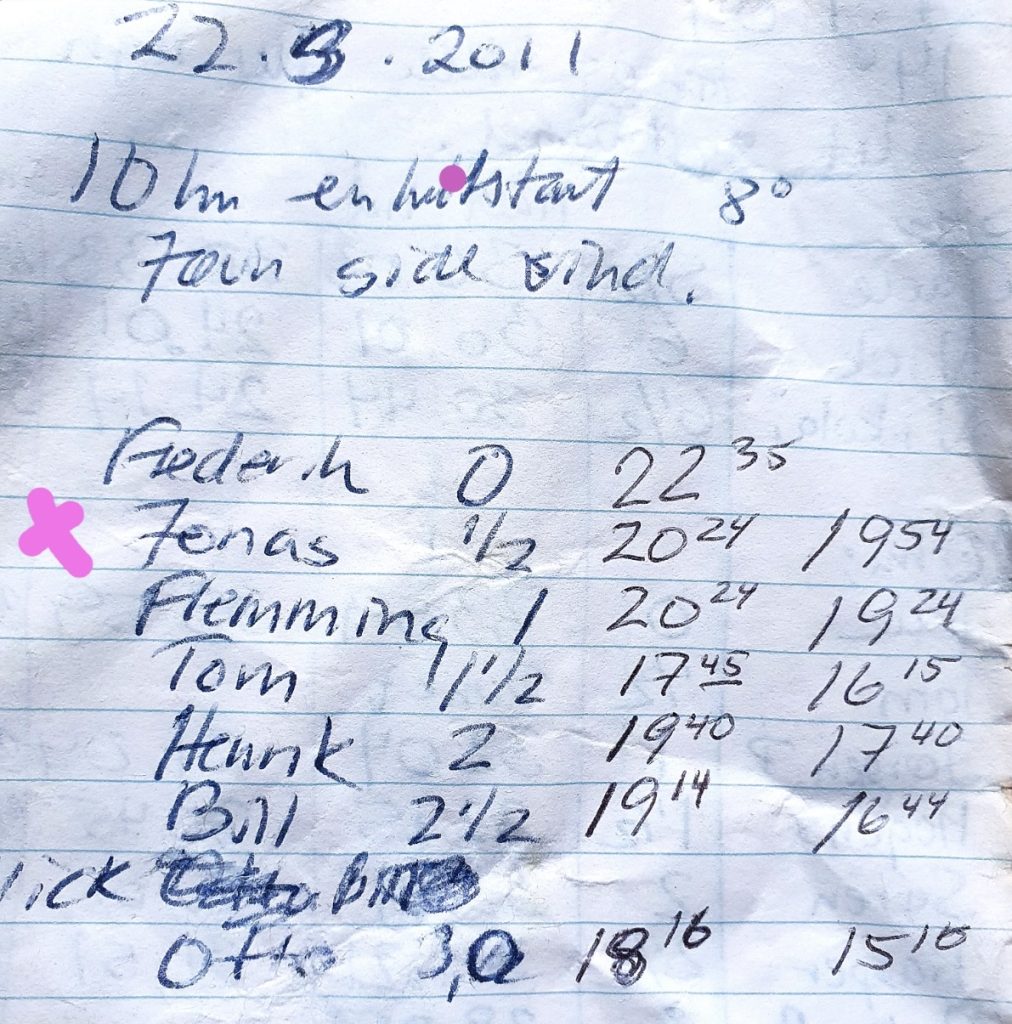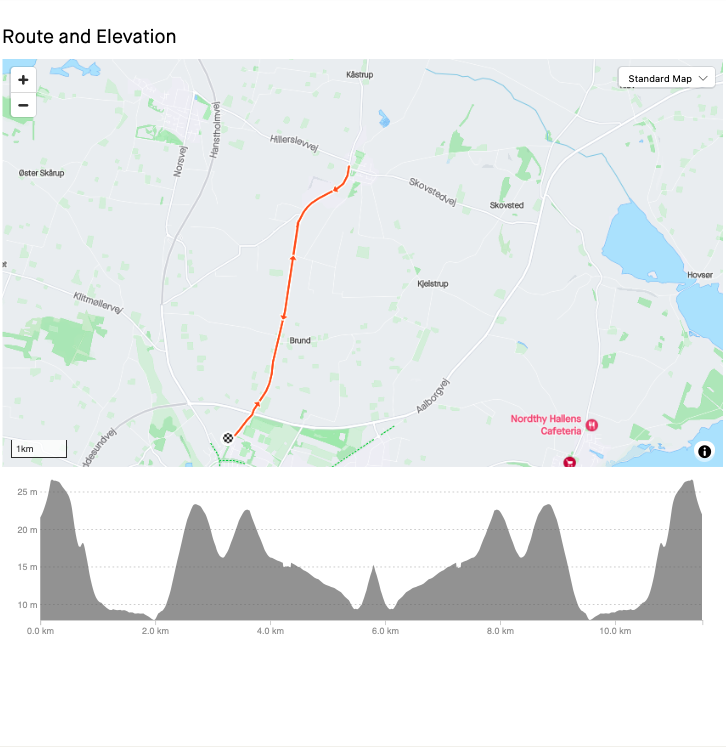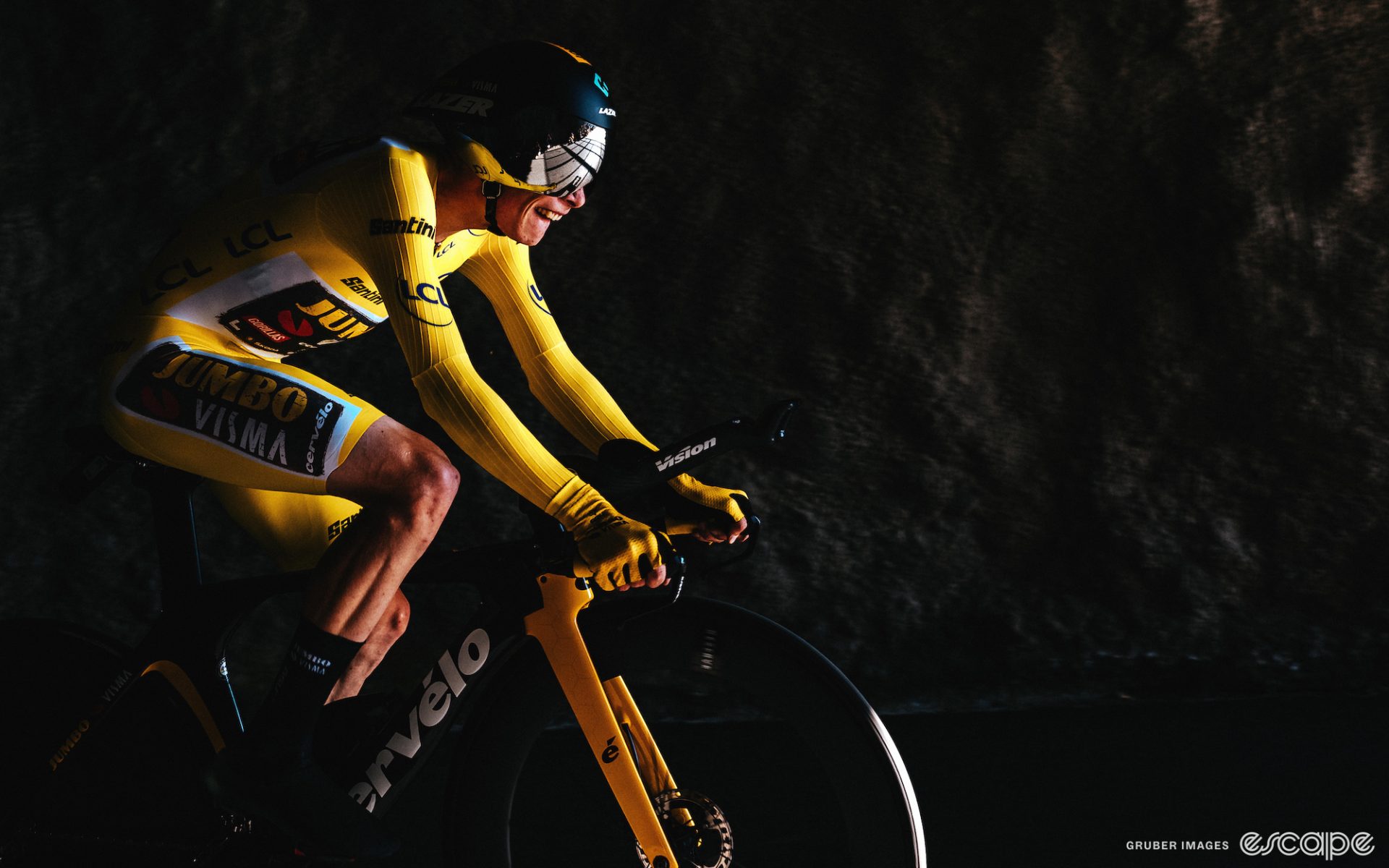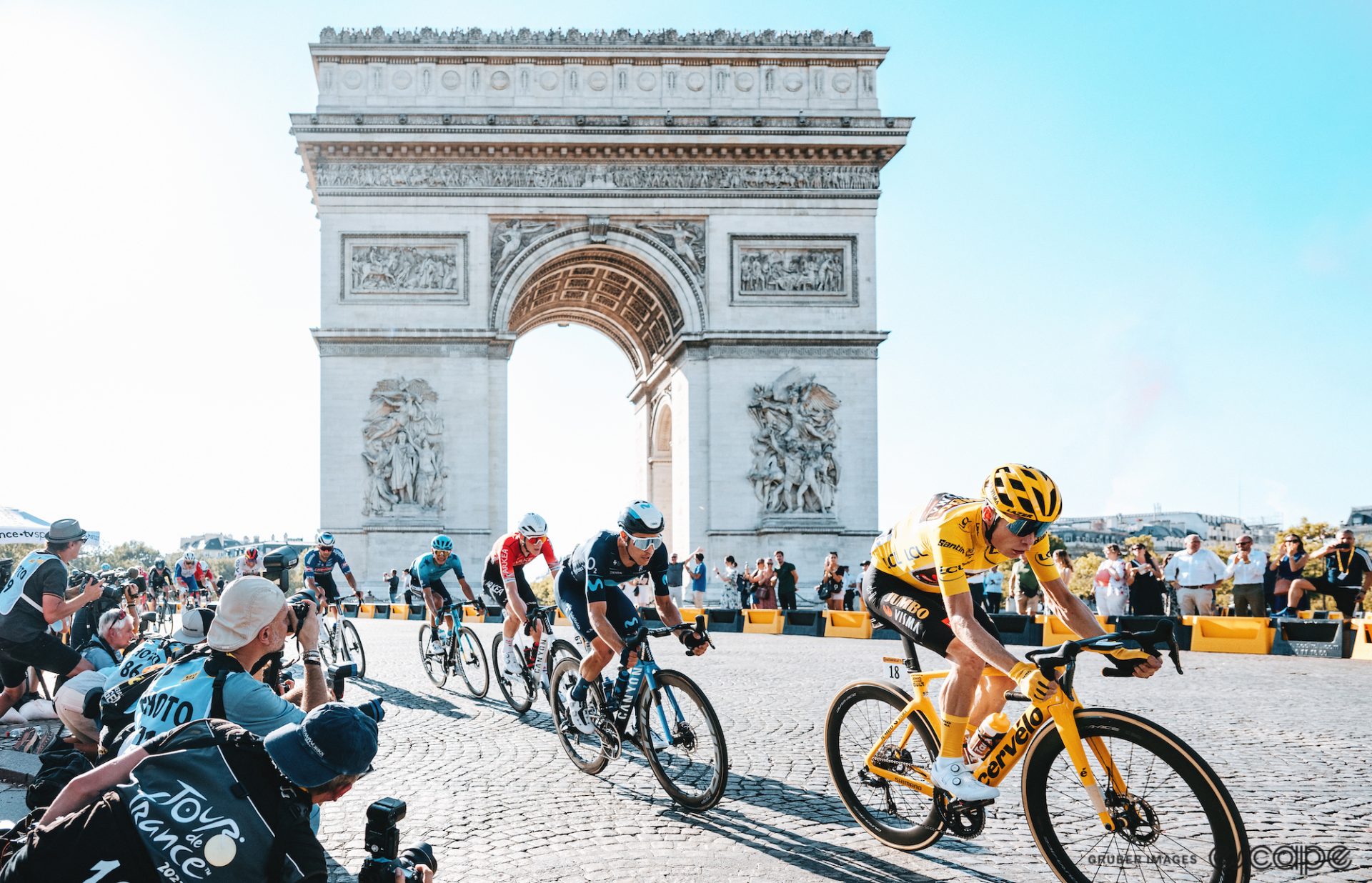It would be easy to think Jonas Vingegaard’s ascent was inevitable: the steady and surefooted progression of a phenomenon, perfected in the Jumbo-Visma machine. From the start of the 2021 season, he has 10 podium finishes in 14 stage races. His 2023 season has been sparse, with just 17 race days so far. But he’s made them count: heading into the Critérium du Dauphiné, his last tuneup before defending his Tour de France title, Vingegaard has seven stage wins and two overall victories, the only slight bobble being third at March’s Paris-Nice behind Tadej Pogačar.
But winning hasn’t always been the order of the day for the Dane. His first few years with Jumbo-Visma were marked by mostly forgettable finishes punctuated by a stage win in the Tour of Poland and the overall at the Stavenger stop on the short-lived Hammer series; hardly the stuff of a legend in the making. In fact, at that Tour of Poland he was so nervous the day after winning that he couldn’t eat dinner or breakfast.
And winning most certainly wasn’t what a young Vingegaard did back in his youth days. Quite frankly, from the moment a 10-year-old Vingegaard picked up cycling in 2007 after being inspired by the visit of the Post Danmark Rundt to the capital of his home region of Thy, he was – his childhood friends say – absolutely hopeless.
“The first thing I remember about Jonas is him coming along to a club training session aged 10 and two or three kilometres in he crashed as we went round this roundabout,” recalls Søren Pugdahl, a one-time Thy Cykle Ring clubmate. “He screamed so loudly we all thought he had broken something. His father and him cycled back to the car together and the rest of us carried on.”
Some bike racing talents seem born to the sport. Vingegaard’s rival Tadej Pogačar, for one: winner of the Tour de l’Avenir in 2018 at just 19 years old, and a podium finisher in his debut Grand Tour as a WorldTour neo-pro a year later.
But Vingegaard, who at 21 was still racing for a small Continental team, was made. I called Pugdahl and other figures from Vingegaard’s youth because I wanted to know how a kid known more for crying on the bike than riding it – the frail, out-of-breath boy with floppy blond hair known as lille skid – ended up as the steely-faced killer who took down a generational talent to win the biggest bike race in the world.
The weakest link
“Jonas was just like a chick from a bird’s nest that had fallen out,” reminisces Ole Iversen, president of the Thy Cykle Ring club. “All the other guys were quite physical and he was very small. I have this very beautiful photo that I took of a young Jonas when an A class (highest category) rider won a local race. In the photo Jonas is looking up at the winner and you could see that he wanted this success so very much, he really admired the winner, but it wasn’t happening for him.”

Tuesday evening club time trials and Thursday interval group rides were the highlights of Vingegaard’s week when he was at school. Iversen, a member of the club since 1988, was always the club’s TT timekeeper and still is, standing on the side of the road with his stopwatch, come rain, snow, wind and very occasionally sun. “The route is always the same: five km out, and then five km back on the home stretch. The turning point is in the middle of his hometown, Hillerslev. If I go back through some of the old race results, you’d have to go a long way down the results to find Jonas. 25th at best.”
As we talk, he is scouring his archives to find a TT result from more than a decade ago. “Can you believe I have a whole folder on my computer about Jonas?” he mumbles. Yep, I can believe it. While he’s speaking, Iversen finally finds what he was looking for. “Here we go. May 2010: Jonas, 18 minutes, 9 seconds. And then March 22, 2011: Jonas, 19 minutes, 54 seconds. 30kph. 8 degrees and a crosswind. You see, it’s not that fast.”
It should be noted that Vingegaard was just 13 and 14 when he clocked those times. Still, says Iversen with matter-of-fact bluntness, “no one thought he was going to make it big in any way because he was often the weakest link in the bunch of the club’s riders and he really struggled in his younger years.”


Nevertheless, Vingegaard was becoming engrossed by two wheels. “Whenever we’d talk it’d be about cycling, the latest results, the best races, new and upcoming stars, equipment he wanted,” says Pugdahl, 10 years Vingegaard’s senior. “It was never personal stuff, he never talked about his education. It was definitely his life, cycling, but he wouldn’t beg his parents to do all kinds of stuff. That’s not Jonas. He would never push for his parents to take him to France or Italy, but if his parents suggested it there would be fire in his eyes.”
One weekend, Pugdahl says, “my family and his family went to a bike trade show, a small version of a Eurobike. He was 11 years old, a little guy with all these bikes and he was in heaven. I remember coming back from the show and within 10 minutes he fell asleep on his father. He had been so happy all day that he was worn out.”
‘You won’t believe this, but Jonas is very strong’
But the lack of personal success wore at him. At 15, Vingegaard was becoming despondent with the sport, telling his father Claus and mother Karina that he wanted to stop riding his bike. They persuaded him to continue, partly by sending him to ISI sports boarding school, 100 kilometres away in Ikast. ISI’s “Cycle Line” program offers structured training and support, including a physiotherapist and four coaches, led by director Morten Knudsen.
ISI was pivotal for Vingegaard; Knudsen was unavailable for comment for this story, but some combination of the new training structure and Vingegaard’s own physical maturation proved transformative.
The following summer, in 2013, Vingegaard returned from a summer trip to the French Alps with his parents and the upturn in form was astonishing. “He came home from France and … holy fuck. He was very, very good,” Karsten Mikkelsen, described as Vingegaard’s first cycling mentor, remembers. “What impressed me most was how he rode on the flat. I am 193 cm and 90 kg so I am good on the flat, but when a boy of 60 kg goes as fast as I do, well, he must be extremely good.”

Word spread through Thy. Pugdahl, who was a Continental pro for five seasons, had moved away from the area, but a friend who had been training with Vingegaard called him. “He said, ‘You won’t believe this, but Jonas is very strong, and he’s incredible on the flats too’,” Pugdahl recalls. “I was like, ‘Yeah right, that’s not gonna happen.’ I went home, went to the club’s training and he nailed everyone. It was this sudden transformation from nothing to almost everything.”
ISI has an association with Herning Cykle Club, one of the oldest amateur clubs in Denmark and which produced Bjarne Riis, but Vingegaard raced for Odder Cykle Club, which also helped develop Kasper Asgreen. In 2016 he was picked up by the UCI Continental team ColoQuick-CULT. To those who knew Vingegaard, that in itself was a success that no one had envisaged.
From fish factory to finishing first
As cycling became his main focus, Vingegaard needed a second job to earn money. You know what he did next because you’ve seen the video from Danish broadcaster DR in 2017: dressed in blue overalls and rubber gloves, Vingegaard shovels ice into a box full of fish at a fish auction. “He must keep his feet on the ground and take one step at a time,” Coloquick-CULT manager Christian Anderson told DR.
He was working at Chrisfish, a small seafood wholesaler with customers across much of Europe, doing the exact same job that childhood friend Michael Valgren, now of EF Education-EasyPost, did a few years before him. Vingegaard, just about to turn 21, would wake up at 5 am and begin his shift at 7am, working until noon with vast quantities of North Sea produce: cod, crab, haddock, monkfish, mackerel, squid, tusk. Quiet, reserved Jonas wasn’t shouting and screaming trying to sell the fish to the highest bidder, but instead writing down the prices of the bidding, scanning the boxes, and updating the information onto the computer. When he wasn’t in the auction, he’d be cutting the tail fins off plaice. He was handsomely paid, pocketing 130DDK (€17.50; $19) per hour.
Was he good? “There were 20 people in the auction and he was doing the easy work,” says Mikkelsen, the co-owner of Chrisfish. “It was simple kind of work, but that’s all he needed – just something to do in the morning before he went out on the bike in the afternoon. You could leave him in the morning and know that when he’d left he’d have completed everything.”

Vingegaard worked there for about eight months when a bad crash at the 2017 Tour des Fjords left him rehabbing a broken femur: unable to race or train but also, for a period, even to work, as he told Eurosport. He returned to the job first. Something about it – the structured schedule, the routine nature of the work – seems to have helped Vingegaard’s focus both before and after recovering from his injury. “I have much more motivation to go out and train when I have worked,” he told DR. But with the 2018 racing season on the horizon, Vingegaard worked less and less. After another eight or so months in Chrisfish’s processing department, his stint in the wholesale fish industry was resigned to the former employment heading on his CV. Cycling was to become his sole focus.
But none of that – not the fishmonger job, nor the physical maturation during his stint at ISI, nor the broken femur or his recovery from it – fully explains how Vingegaard transformed from the eager-yet-inept preteen to the cool, collected racer whose calm demeanour disguises a fierce drive. For that, you have to look back to something earlier, something more innate, something that maybe we missed in young Jonas.
‘The next week he was there’
The region of Thy sits hard against the North Sea on the northwestern-most edge of the Jutland peninsula. Life in the region comes with its difficulties: relentless coastal wind, rain, and winter days with as little as seven hours of sunlight. Sitting at the opposite end to the country’s parliament, it’s the sort of place that the British press would term as left behind, a backwater. It’s an area dependent on agriculture, fishing, and small and medium industries. The people are not rich, but they are proud. Stubborn, too.
“The mentality of training in Thy has formed who Jonas is,” says Pugdahl. “We have a lot of small, open roads. Many of them are straight, so it’s all open, windy spaces. The longest climb is around 100 metres high. That mentality to go training every day, no matter the weather, toughens you up. You go to training, you train hard, you never stop. If you have a puncture, you fix it yourself and get back on your bike. If it’s windy or raining, you don’t call your parents but make it on your own. You see it in both Jonas and Michael: they are very tough guys.”

That day, so many years ago, when Vingegaard crashed in the roundabout and his father took him home? “Everyone was saying how we’d never see him again,” says Pugdahl. “But the next training session he was there.”
Iversen recounts a similar tale: “On one of his first rides Jonas couldn’t get through the session and he called his father to pick him up. His father came and threw the bike in the back of the car. We didn’t think he would come again, but the next week he was there.”
Words like tough and resilient are common when people are asked about Vingegaard. Louis Bendixen, now of UNO-X, raced with Vingegaard when they were riding for ColoQuick-CULT in 2016 and 2017. “When you ask me how Jonas is as a person, I think of his insider anger, the ‘Fuck it, I’m gonna smash all the guys’ mentality that a lot of top riders have,” Bendixen says. “It’s nothing you’d expect him to have, but he developed it. You don’t win the Tour de France without also being a badass. That comes from his childhood: it was a very calm, very classic, old Denmark upbringing. People from his area have a dry sense of humour, dry dad jokes. That’s his weapon: he’s very good at staying calm, but he doesn’t hesitate to be a badass.” That’s not the only quality Thy imbued in him.
I mention Bendixen’s observations to Pugdahl, and he shocks me by beginning his answer with “When we went to parties together …” I immediately stop him. Sorry, what? Jonas Vingegaard is a closet party animal? “Nothing like that,” he responds, instantly deflating me. “At the beginning he’d be very quiet, but as the night went on, when more people went home, Jonas would start to wake up. When the party was almost over, Jonas was more comfortable. Not because he was drunk, but when there are less people around him he talks more, makes jokes, and when he opens up he can actually be a funny guy. He just doesn’t need the attention: he’s not the one standing on the table saying, ‘Hey everyone, look at me’.”
Close to home, a world away
Nowadays, Vingegaard lives in Glyngøre, 45km, two bridges, and a whole different island away from Thy. It’s a short journey in reality, but Vingegaard chose it to avoid intrusion. He has even changed his phone number and to speak with him people have to go through his partner, Trine. “It’s very hard to contact him,” Iversen says. Some of that is necessity born from his massive popularity at home.
He now has his childhood mentors and friends at arms-length, but he hasn’t departed from his roots entirely. Upon winning the Tour, he agreed to Iversen’s request and donated two signed yellow jerseys to the club, which were subsequently sold to purchase six new Orbea bikes for local children to use. “Jonas backed the plan and now the circle is closed: with that gesture from him, every child who comes to the club can borrow a brand new race bike and all the equipment for free,” says Iversen.
Two months after the Tour triumph, his father Claus was clearing out his garage and, with Jonas’ permission, they repaired and then donated his first two carbon bikes to the club. “Young kids from the area now train on Jonas’s first ever bikes,” Iversen smiles. “They have this magical aura around them, it’s very special. Jonas doesn’t show up in our area much now, he minds his own business and doesn’t want people making a fuss about him, but with the signed jerseys and the bikes, that’s his way of supporting us.”
The second Saturday of every April, Thy Cykle Ring puts on a large race called Sparekassen Thy Løbet, colloquially known as “Nasty in the North.” Some 800 cyclists from all over Scandinavia and northern Europe come to ride it, and Claus drives the broomwagon. “They are shocked when they find out that the person picking them up after a flat tyre is Vingegaard’s father,” Iversen laughs. “Claus is the perfect man for the job; he is still helping us, he can’t let it go.” This is the same Claus who, when his son was closing in on an unfancied second place at his debut Tour in 2021, told the Danish press that while “it is so crazy” and “basically you want to shout and scream, cheer, jump and dance, you’re Jutish (from north Jutland), so you don’t do that.”
Like father, like son: Jonas is a product of his upbringing, shaped by his environment. His former clubmates don’t see much of the kid who was once really quite pants on a bike, but they’re sure all that glory has not changed him one iota. “I think of Jonas as a typical person from Thy,” Pugdahl summarises. “He is obviously making a lot of money now, but he hasn’t changed; his feet are still on the ground. He’s like his father, who I’d say is a typical old man from Thy: not impressed by money or having a microphone in front of his face. That’s why the Danish love him so much, because he’s still just Jonas.”
Chris Marshall-Bell is a cycling journalist based in Valencia, Spain. This is his first story for Escape Collective.
What did you think of this story?

